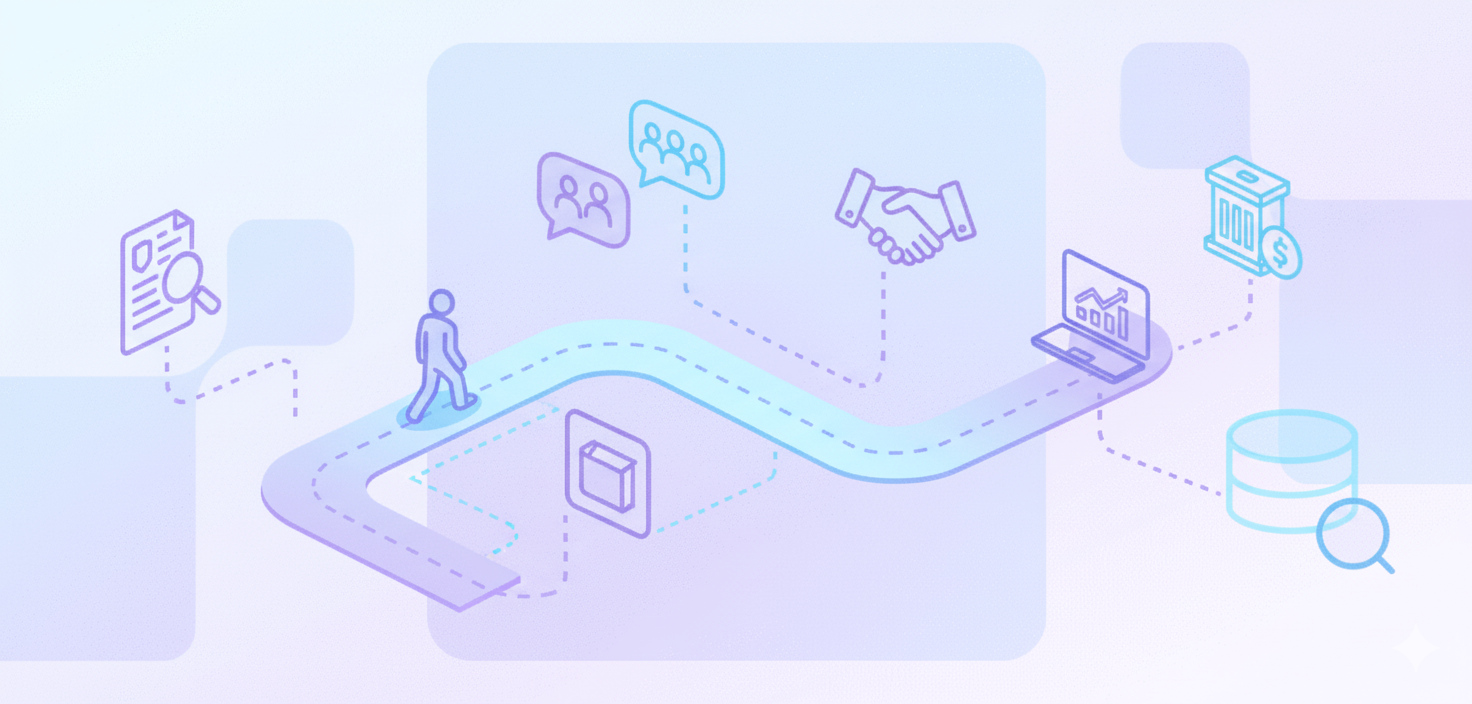marktanalyse
Wat is de B2B-klantreis?

Wat is de B2B-klantreis?
De B2B klantreis vertegenwoordigt de stappen die bedrijven doorlopen wanneer ze interactie hebben met andere bedrijven op het gebied van marketing, verkoop, klantenservice en ondersteuning tijdens het verkoopproces.
Het omvat een aantal contactmomenten, en het duurt meestal langer dan de typische B2C transactie.
Inzicht in de B2B klantreis kan marketingstrategieën en de klantervaring beïnvloeden, wat mogelijk van invloed is op bedrijfsresultaten.
Wat zijn de belangrijkste fasen van de B2B klantreis?
De B2B klantreis omvat de volgende fasen:
- Bewustzijn
- Overweging
- Beslissing
- klantenbinding
- Ambassadeurschap.
Deze fasen vertegenwoordigen de levenscyclus van de klant, vanaf de bewustwording van het bestaan van het merk tot het ambassadeurschap.
Sommige modellen omvatten Onboarding en Adoptie, wat mogelijk van invloed is op de klant succes.
Overweeg elke fase afzonderlijk en houd rekening met klantemoties en pijnpunten voor gepersonaliseerde oplossingen.
Wat activeert de B2B klantreis?
Triggers zijn acties of omstandigheden die B2B-kopers motiveren om verdere stappen te ondernemen in het aankoopproces.
Deze triggers kunnen de erkenning zijn van een probleem dat de moeite waard is om aan te pakken, het begin van het onderzoek naar een oplossing voor dat probleem, of een van de vele andere situaties waarin de verkoper een gratis proefperiode aanbiedt.
- Begrijp deze triggers bij het opstellen van een marketingstrategie die inspeelt op de behoeften van de individuele koper in elke fase van de klantreis.
- Activatiepunten dienen te worden gedefinieerd op basis van de persoonlijke kenmerken en voorkeuren van de persona.
Hoe evalueren B2B klanten oplossingen?
Hier is een stap-voor-stap proces:
- B2B-klanten beginnen met het overwegen van diverse oplossingen, het vergelijken van functies en het beoordelen van de aansluiting bij hun specifieke behoeften.
- Vervolgens gaan ze over naar een evaluatiefase met gedetailleerde demo's, pilotprogramma's en formele beoordelingen waarbij meerdere belanghebbenden betrokken zijn.
- Tot slot geven beslissers prioriteit aan oplossingen die een naadloze integratie met de bestaande infrastructuur bieden, naast sterke prestaties en betrouwbaarheid.
Een bedrijf zou leveranciers kunnen vergelijken op basis van kosten, functionaliteiten en prijsstelling, terwijl IT wordt betrokken om integratiemogelijkheden en beveiliging moet beoordelen. Verkopers moeten zich richten op het afstemmen met kopers over de probleemdefinitie, aangezien probleemgerichte benaderingen effectiever zijn, en erkennen dat content die vóór het eerste contact wordt geconsumeerd, de vroege evaluatiestadia aanzienlijk beïnvloedt.
Hoe onderzoeken B2B klanten doorgaans oplossingen?
Klanten die op zoek zijn naar producten en diensten die beschikbaar zijn op B2B-markten, doorlopen een aantal stappen voordat ze een aankoopbeslissing nemen. Dit omvat het gebruik van:
- zoekmachines
- branchepublicaties
- aanbevelingen van collega's
- gesprekken met verkoopvertegenwoordigers.
Dit proces wordt ingezet om een specifieke zakelijke behoefte te identificeren, een plan voor de oplossing te creëren en vervolgens beschikbare oplossingen met het plan te vergelijken.
Welke invloed heeft de klantervaring op B2B-aankoopbeslissingen?
Klantervaring staat centraal als een belangrijke factor bij het stimuleren van groei, winstgevendheid, klantenbinding, en loyaliteit in B2B-transacties.
Het lijkt erop dat consumenten het ‘consumerization’-concept beginnen toe te passen op B2B. Consumenten geven de voorkeur aan vereenvoudigde zakelijke interacties, hoffelijke service en soepele aankoopprocessen. Als we organisaties vergelijken die strategieën hebben geïmplementeerd om te verbeteren en organisaties die dat niet hebben gedaan klantbeleving, de laatste groep onderscheidt zich door haar kostenbesparingen, hogere omzet en verbeterde Klanttevredenheid.
Wat zijn veelvoorkomende pijnpunten in de B2B-klantreis?
Typische zorgen zijn onder meer de hoeveelheid informatie die van verschillende leveranciers wordt ontvangen, de inspanning die nodig is om betrouwbare bronnen te identificeren, het ontbreken van een goed gedefinieerde businesscase en een veelheid aan belanghebbenden.
Deze factoren brengen complexiteiten met zich mee die de kwaliteit van de klantervaring kunnen beïnvloeden. Journey mapping kan worden ingezet om deze pijnpunten te identificeren en aan te pakken.
Als de klantreis van een klant een aanzienlijk aantal negatieve gebeurtenissen bevat, kan dit gerelateerd zijn aan een hoger klantverloop.
Hoe kan de B2B-klantreis worden verbeterd?
Hier zijn de stappen voor het verbeteren van B2B klantreizen:
- Breng de bestaande B2B klantreis in kaart om alle contactpunten en de mogelijkheden voor verbetering te identificeren.
- Gebruik data-analyse om waardevolle inzichten te verkrijgen in klantgedrag en voorkeuren in elke fase van het proces.
- Digitale hulpmiddelen en strategieën kunnen de ervaring en de aanwezigheid van obstakels beïnvloeden.
- Het zoeken naar klantfeedback en het ontwikkelen van connecties kan de klantloyaliteit en verdere ontwikkeling beïnvloeden.
Conclusie
De B2B klantreis is een essentieel kader om te begrijpen hoe bedrijven met elkaar samenwerken, en omvat fasen van bewustwording tot belangenbehartiging. Een effectieve uitvoering van deze reis is afhankelijk van het identificeren van triggers, het aanpakken van pijnpunten en het inzetten van data om de ervaring in elke fase op maat te maken. Klantervaring en continue verbeteringsinspanningen kunnen bijdragen aan klantenbinding en bedrijfsgroei binnen het B2B-landschap.